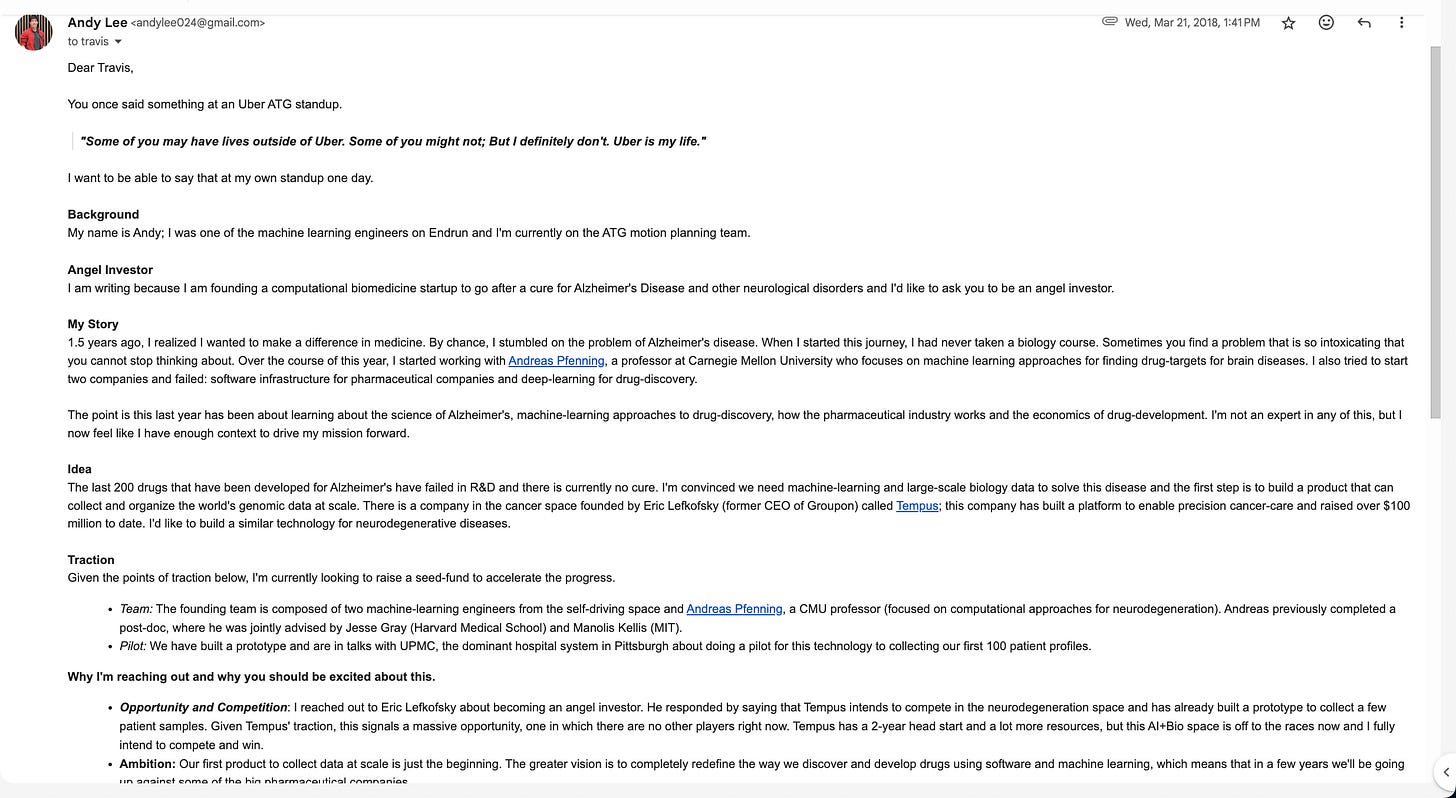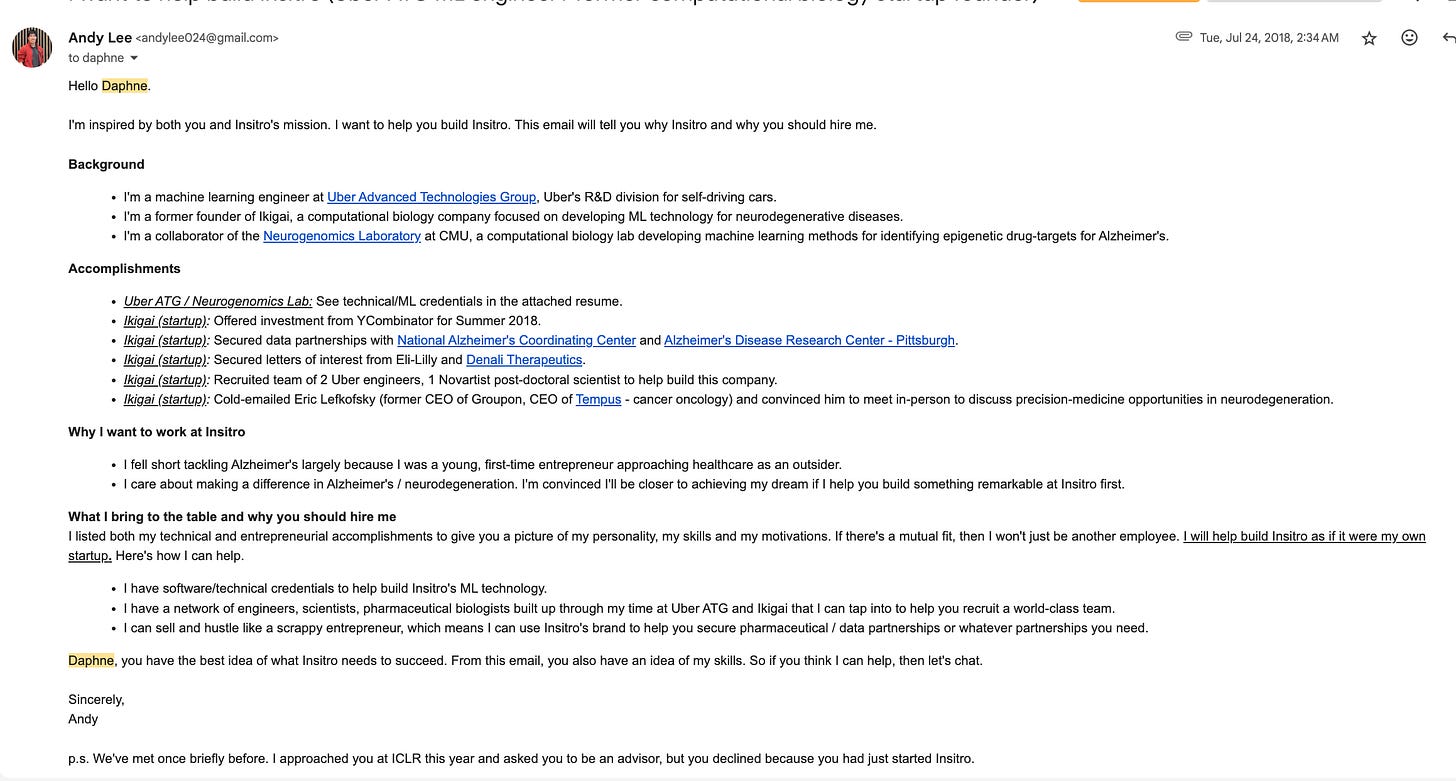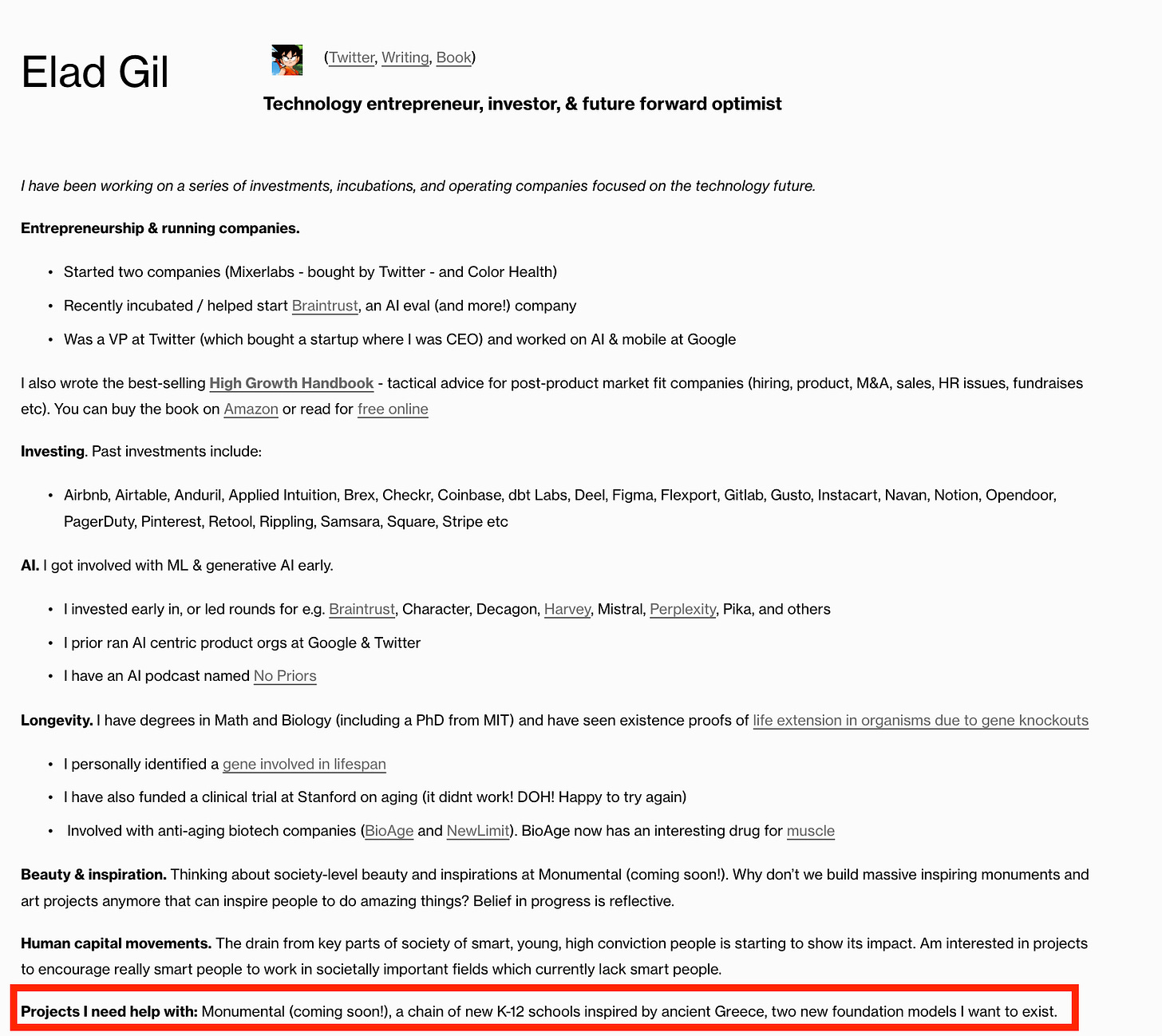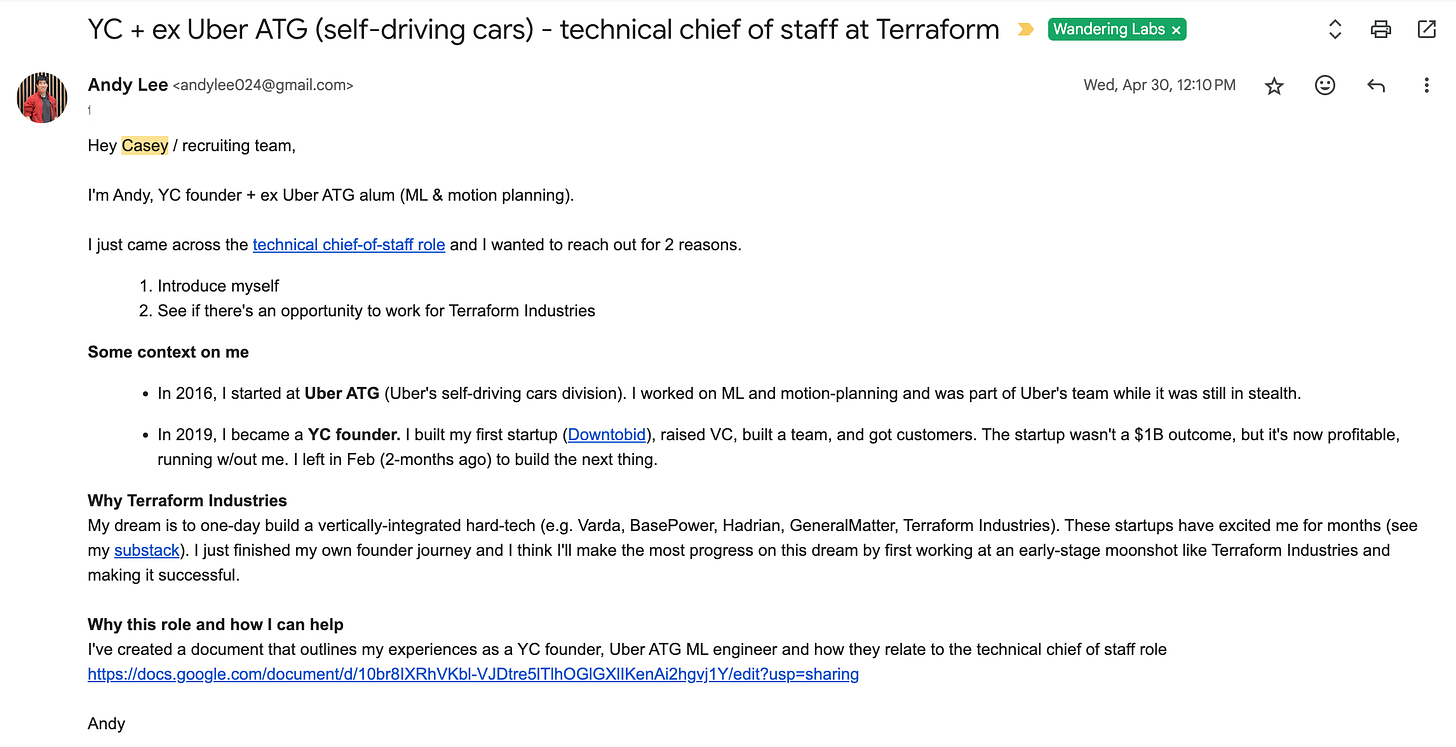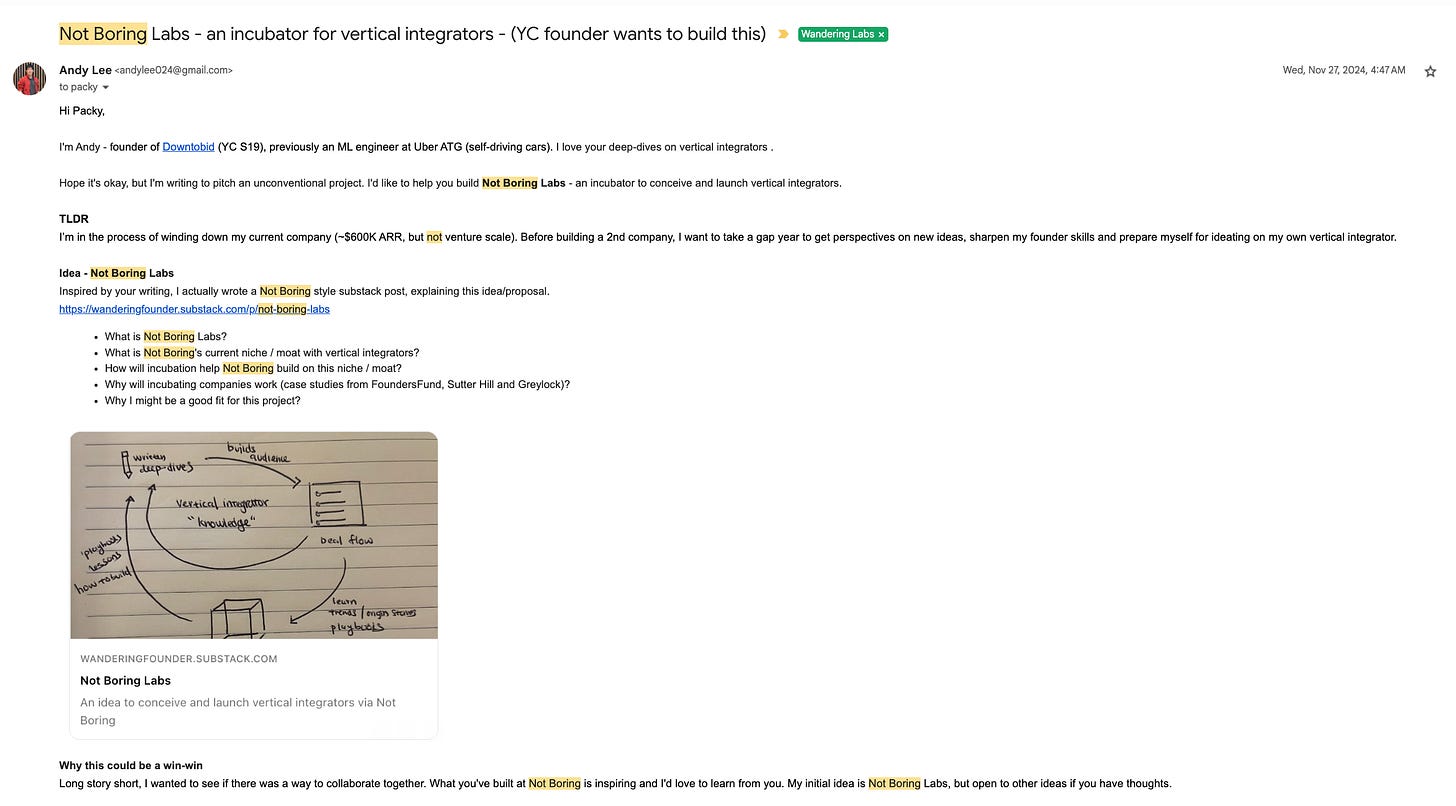I regularly cold-email billionaires and “important people”.
To my surprise, more than half respond.
Some of these people are very famous
Travis Kalanick (former CEO of Uber, worth $3.3 billion)
Eric Lefkofsky (former CEO of Groupon, CEO Tempus, worth $5.6 billion)
Daphne Koller (former founder of Coursera, CEO of Insitro)
When the first billionaire responded, I was surprised because I’m not famous, rich or influential. After the 2nd and 3rd billionaire responded, I realized I actually learned an important skill of writing useful emails. Over time, I’ve used this skill to land my best professional opportunities (Uber ATG, YC , a new job at a FoundersFund incubated nuclear startup called General Matter).
I went through my old emails and noticed for 4 principles in my emails
establish competency
make my ask
be transparent with my self-interests
show extra effort
Hitting these 4 principles is the closest thing I’ve found to a reliable formula for generating responses from influential people. Since writing good emails isn’t an intuitive skill, I want to explain these 4 objectives and show the exact email copies I sent to Travis, Eric, Daphne. I believe cold-emails are underutilized so I hope this will inspire more people to write good emails, which will hopefully unlock more opportunities for people.
Think of a cold-email as a written invitation to explore a potential win-win.
Start with 2 questions
For you : What do you want from this person?
For them : What can I offer that would make it worthwhile for the other person to say yes?
A good cold-email is like trading Pokemon cards. If the billionaire is excited by the trade (e.g first edition Charizard for a Blastoise EX), he/she will respond. If the billionaire isn’t excited, you won’t get a response. This is actually the most important insight with cold emails. The actual trade matters far more than how you communicate the trade. it doesn’t matter what subject-line you use, how long/short your email is, whether you use warm-intro. If the trade is bad, you won’t get a response. Conversely, if the trade is great, you’ll get a response even with a poorly written email.
This is an email I sent to Travis. For context, I was starting a new company just about the same time as Travis had left Uber and started his venture fund 10100 and in my eyes there was a win-win.
Here’s how I interpreted the win-win
For me : I might get Travis as an angel investor, which gives me street cred + mentorship
For Travis : I was a young Uber engineer trying to build an ambitious company with a unique insight on the market. If I’m successful, then it looks good for his investment firm.
Before drafting an email, spend 90% of your energy thinking through the trade. The right time to write an email is when you genuinely believe both you and recipient will be excited by a trade. Once you’ve got the right trade in mind, here are ways to improve your chances at getting a response.
When you write an email, you should be surgical about the things you include and exclude. Every point in your email should serve a purpose.
Start with this question.
What does this person need to know in order to properly evaluate the trade I’m proposing?
The first thing to establish is competency. In a world where billionaires receive 1000s of emails (most of which are shady, untrustworthy spam emails), what can you say in 1-2 sentences that compels a billionaire to take you seriously and properly evaluate what you’re asking for?
Consider these two opening lines.
Hi I’m Joe
Hi I’m Andy (I’m a YC founder, formerly an ML engineer Uber for self-driving cars)
Which line is more powerful? Why?
The first line is bad because it conveys no information. The second line is is more powerful because YC & Uber are brands that signal competency and it’s closer to the type of person a billionaire probably works with.
There are multiple ways to communicate competency
Networks (e.g Harvard, Uber, YC)
Hard things you’ve done (e.g. I built a rocket in 30 days)
Influential people you know (e.g. Elon Musk told me to talk to you)
The best signals for competency are achievements that are noteworthy and difficult to do. In your opening line, you should aim to communicate as competency in as few words as possible.
After establishing competency, the second step is to make an ask.
A good ask communicates two things well.
What : What do you want (e.g. to invest, to get a job, to do a podcast)?
Value: What value does this add to their lives?
It goes without saying that you’ll only get a response if a billionaire sees value in what you’re offering so it is worth spending a lot of effort in figuring out what a billionaire might want. Be brutally honest with yourself about whether you can deliver compelling value.
What most people get wrong is they think email is about persuasion. Cold email is actually a test of whether you understand what another person truly values; a response is just the byproduct of true understanding. This is why before reaching out I will read a billionaire’s blog posts, look at their projects and watch their interviews. All of this work is to build intuition for “what this person might want”.
What projects are they working on?
What causes do they care about?
What motivates them?
What are the problems they’re trying to solve?
Who do they typically help? Why?
There’s no way to know these answers with 100% certainty, but your job before writing an email is to do the research to make an educated guess on what this person wants. For Daphne (founder of Coursera), I wrote this email just as she was starting her new company Insitro so I positioned myself as an early employee that would do everything I could to help her new company succeed.
Billionaires are people who constantly strive to achieve new things. It’s often not hard to deduce what they might care about because they are public with their projects. Figure out how you can help them and lean into that in your emails.
For example, look at Elad Gil. He literally writes exactly what he needs help with on his website.
A third (often underutilized) technique is to slightly over-communicate your self-interests.
Self-interest : Why do you want the billionaire’s help? What does this do for you?
My theory is that influential people want to work with people that are competent, trustworthy and internally-motivated because these are indicators of success. But how do you actually signal this? To signal trustworthiness be transparent with your intentions. To signal internal-motivation explain how this trade aligns with your long-term ambitions.
Here’s an example of a recent email I sent to a founder asking for a job; notice how I explain how the job fits into my long-term ambitions.
My fourth and final objective in an email is to show extra effort. How can I make an effort beyond email and show someone I’m serious about working with them?
For example, I recently sent an email to Packy McCormick (founder of Not Boring), pitching him on co-building a startup incubator. In addition to the email, I also wrote a blog post (Not Boring should incubate companies) to show that I’ve thought about the idea and how it strategically benefits Not Boring.
Although the idea wasn’t the right fit for Not Boring, Packy was kind enough to hop on a call and talk it through with me. The lesson is that even if your value prop misses the mark, making a real effort to create something thoughtful before reaching out goes a long way—people notice and appreciate it. Effort signals you’re trying to give more than take. It shows you’re serious enough to invest time in bringing your idea to life, not just pitching it.
The truth is there’s no exact formula for writing a perfect email that gets a response from a billionaire.
However, there are certain guiding principles that I’ve found effective in emails.
Competency : to establish yourself as a potential collaborator
Ask : to communicate the win-win behind the trade you’re proposing
Transparent self-interest : To show that you’re trustworthy and motivated
Effort : To signal that you’re willing to give more than you take
The goal of this essay is not to prescribe a rigid process for writing emails, but to introduce a set of principles / traits / considerations that I often consider when cold-emailing. How you put this into practice is a form of fun creative expression!
Now you’re ready to go off, come up with awesome trades and cold-email people!
p.s. Thank you Daniel Kang for reading a draft and providing comments
.png)

